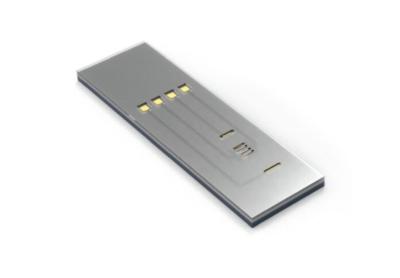The Graphene-Info weekly newsletter
Published: Tue, 10/25/22
The Graphene-Info newsletter (October 27, 2022)
Cannot read this? View it online here
Graphene assists researchers to develop a novel nondestructive imaging platform
Researchers from Lawrence Berkeley National Laboratory and University of California at Berkeley recently used graphene to develop an imaging platform that enabled nondestructive spectroscopic imaging of soft materials with nanometer spatial resolution, under in vitro conditions and external stimuli. Using the Advanced Light Source (ALS) particle accelerator as an infrared light source, the researchers performed the nanometer-scale spatial resolution imaging of proteins in the proteins’ natural liquid environment. They observed how the self-assembly of the proteins was affected by environmental conditions in the surrounding liquid.
Current imaging tools often use ionizing radiation under conditions that are far from the molecule’s native biological environment. Powerful imaging techniques such as fluorescence microscopy can potentially damage biological material, and they often do not provide chemical information. To resolve this challenge, the researchers combined nano-Fourier transform infrared (nano-FTIR) spectroscopy with graphene-capped liquid cells. The imaging platform could open opportunities in the study of soft materials for sectors that range from biology to plastics processing to energy.
Researchers use graphene oxide to create a self-powered sensor that translates sign language into audio
Researchers from Tsinghua University recently developed a self-powered sensor that can monitor and detect multiple environmental stimuli simultaneously and demonstrated how it can “translate” sign language into audio.
The sensor was made from graphene oxide and powered internally by a moist electric generator called MEG, which contains a membrane that spontaneously absorbs water from the air. When water adheres to the surface, this results in a higher concentration of hydrogen ions at the top of the membrane and a potential difference between its two electrodes.
Nanotech Energy Europe enters agreement to supply graphene-based battery energy storage systems (BESS) in Greece
Nanotech Energy Europe, a fully owned subsidiary of Nanotech Energy, has announced it has signed a purchase agreement to supply 1+ GWh size BESS (battery energy storage systems), based on graphene technology, through 2028 to Smile Energy in Athens, Greece.
Nanotech stated that the partnership with Smile Energy will allow the immediate expansion of Nanotech's energy storage business to a region which has committed to developing the world's preeminent solar infrastructure. Together, Nanotech and Smile will play a role in supporting Greece and the surrounding region to take the next steps to ensure stability of infrastructure and continuity of energy supply.
Recent Graphene Industry News - October 2022
Here are some recent and popular graphene industry updates that you may find of interest:
- Skeleton Technologies launches its graphene SuperBattery and unveils Shell as partner
- Researchers use graphene electrodes to split water molecules
- New graphene-enhanced asphalt installation in the UK
- William Blythe expands its graphene oxide capacity to 50 tonnes as demand increases
- Black Swan Graphene is now a public company, with a $52 million market cap
- LG launches graphene-enhanced earbuds
- Viritech launches graphene-enhanced hypercar
- PolyJoule unveils graphene-enhanced polymer batteries
- Haydale to lead project for high barrier monolayer films for food packaging
- NeoGraf Solutions inaugurates its 750-ton graphene production facility
- WearGraphene's graphene-enhanced jacket - a hands-on review
- Are graphene batteries finally getting closer to commercialization?
- Graphene oxide gives a boost to new intranasal flu vaccine
Levidian announces international investment from Baker Hughes
Levidian has secured financial backing from US energy technology giant Baker Hughes (Nasdaq: BKR) a £12 million investment.
The funding will enable the further scale up of Levidian’s business, including both LOOP, Levidian’s decarbonization device, and graphene production capacities at its Cambridge headquarters – allowing Levidian to capitalize on the significant interest in its ground-breaking work.
Directa Plus to supply graphene for 250 km Italian motorway road surfacing project
Directa Plus has announced that its G+ graphene will be used in the asphalt for a 250 kilometer (km) motorway section in Italy, along with selected recycled hard plastics such as toys, fruit crates and litter bins, to make a product called Gipave. The contract to use the Gipave asphalt ‘supermodifier’ in the road surfacing of the A4 Torino-Milano motorway section was won by Directa's Italian partner Iterchimica with motorway management and infrastructure specialist ASTM Group.
Gipave uses Directa's graphene to improve resistance and life span for road surfaces.
Researchers design impressive all-in-one miniature spectrometers using graphene and Mos2
An international team of researchers, including ones from Aalto University, Shanghai Jiao Tong University, Zhejiang University, Sichuan University, Oregon State University, Yonsei University and the University of Cambridge, have designed a miniaturized spectrometer made of a ‘sandwich’ of different ingredients, including graphene, molybdenum disulfide, and tungsten diselenide.
The spectrometer reportedly breaks all current resolution records, and does so in a much smaller package, thanks to computational programs and artificial intelligence. The new miniaturized devices could be used in a broad range of sectors, from checking the quality of food to analyzing starlight or detecting faint clues of life in outer space.
Archer Materials announces wettable graphene transistor for biochip tech
Australia-based Archer Materials has developed a graphene-based field effect transistor (gFET) that can operate in wet environments. The gFET device is a sensing component which will be used in medical applications, like for digitizing biologically-relevant signals such as those from target analytes of viruses or bacteria. The biochip innovation will be integrated with advanced microfluidic systems to allow the manufacturing of mini lab-on-a-chip device platforms designed for medical diagnostics.
The company explained that the integration of gFETs with on-chip microfluidics potentially enables multiplexing, such as the ability to parallelize the detection of multiple biologically relevant targets in droplet-size liquid samples on a chip. The innovation can prevent liquids from shorting the integrated circuit, while simultaneously obtaining electronic signals using the liquid as part of the device.
Metalgrass LTD
9 Har Tsin St.
Kfar Sava Hasharon 4430809
ISRAEL
Unsubscribe | Change Subscriber Options






